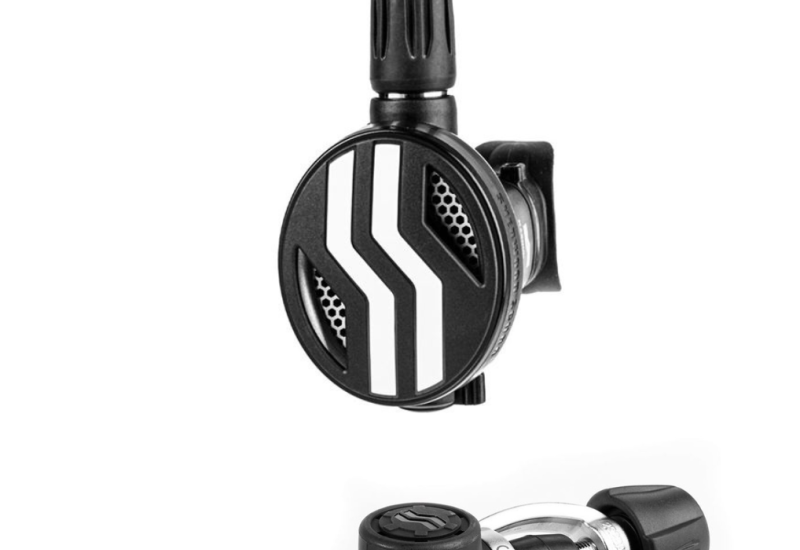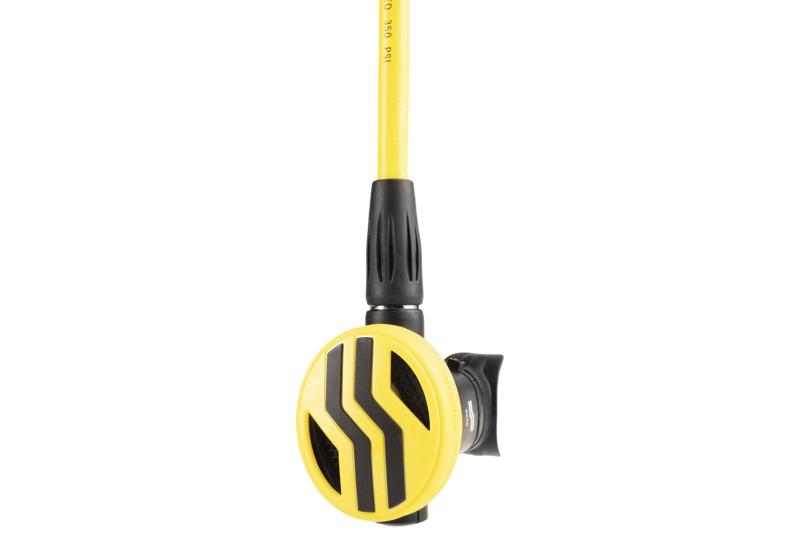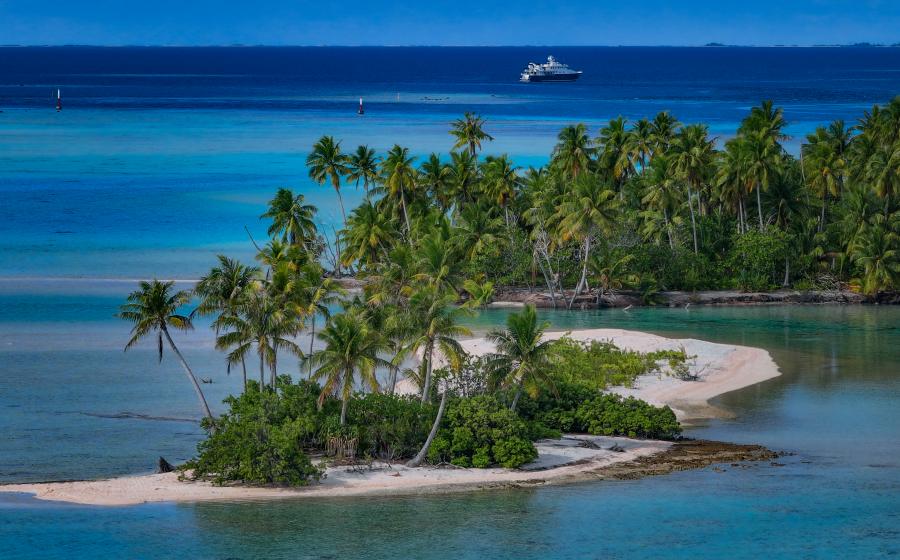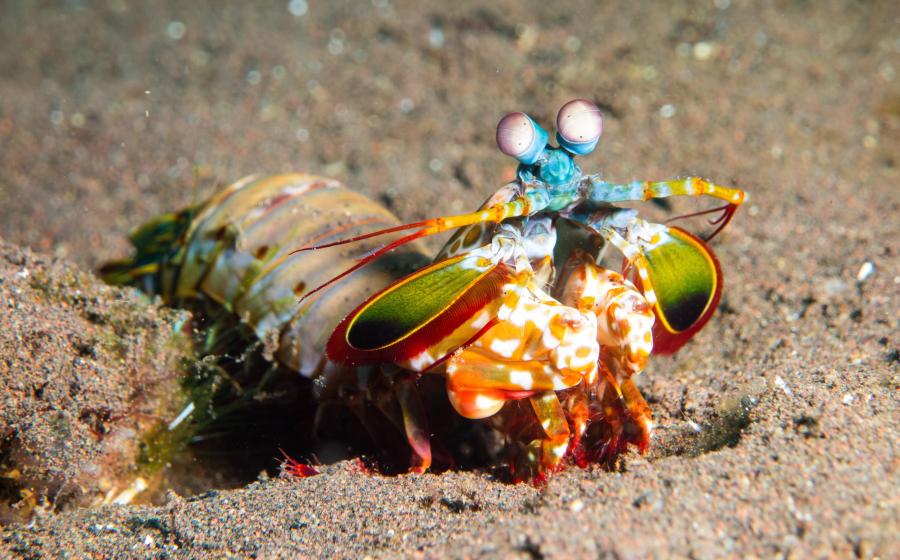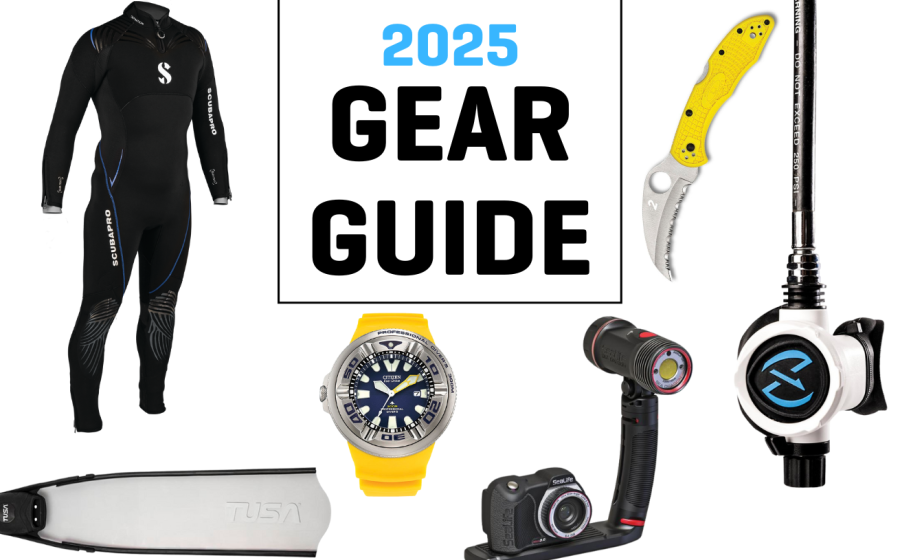16 New Budget Regulators
March 2001
By Jon Hardy
Regulators Reviewed in This Article
| Aqua Lung Micra ADJ Aqua Lung Titan Glacia Genesis Scuba Atlas Genesis Scuba Yukon IDI Seaira Spirit Dia IDI Seaira Spirit Flowby IDI Seaira Tri-Metal IST R600 Saturn | IST R700 Imperial Mares MR 12 Axis Mares MR 12 Epos Mares R2 Axis Oceanic Explorers Ocean Reef 6600 Dynamic Ocean Reef Enterprise 6010 Ocean Reef Enterprise TR94 Polar |
Reviewed here are 16 new or redesigned regulators that retail for $400 or less. Among them are eight Testers' Choices, seven Best Buys, two regs that completely failed and three that had marginal performance. Prices run the gamut from $200 to $400, with six regulators under $300 earning honors as Testers' Choices, Best Buys or both. That's the good news for consumers. The bad newsseveral of these regs clearly should not be used for scuba diving.
The Testers
These eight testers made more than 130 ocean dives while testing these regulators: Vicki Durst, Jon Hardy, Bruce Haveri, Mike Jones, Jason Manix, Ron Moore, Pete Pehl and Susie Regiembal. Jason Manix and Ron Moore also shot several hours of videotape for later analysis.
Laboratory Testing (Breathing Simulator)
All 16 regulators were first checked to ensure they functioned correctly and operated within specifications. Next, at two different engineering labs, each regulator was tested on a computer-controlled breathing simulator to stress it to extremes under controlled conditions. The results of these tests were then compared to those of all other regulators in this test group. Both U.S. Navy and European (CE) standards were used to evaluate performance. Although hundreds of tests were recorded, scoring was based on the following four criteria:
Work of Breathing at 99 feet. The U.S. Navy standard test was run at this depth to establish a baseline for performance. All regulators should have passed this with ease, but five did not.
Work of Breathing at 198 feet. This is the Navy's standard test, with a supply pressure of 1,500 psi, a breathing rate of 25 breaths per minute and volume of 2.5 liters per breath. This is expressed in joules per liter with a maximum 1.4 j/l allowed.
Loss of Performance from 99 to 198 feet. If a regulator's performance changes very little with increasing depth, it will be more stable and far easier to use.
Positive Pressure Breathing at 165 feet. Positive pressure breathing occurs when a regulator delivers more air than is demanded by the diver. In other words, the regulator forces air into the diver's mouth. This is an unnatural way to breathe and may cause the regulator to be less stable and lead to leaks, free flows and possible harm to the diver, although this has not been proven. We used the European CE criteria for the cutoff point.
The perfect regulator would hold a steady, low work of breathing with little or no positive pressure and little or no loss of performance with increasing depth or decreasing supply pressure.
Ocean Testing (Subjective Ergonomics)
1) Bubble Interference. When looking down, straight ahead, up at a 45-degree angle or straight up, do the bubbles rise into the diver's field of view?
2) Adjustments. If the regulator has diver-controlled adjustments, how easy are they to find, grip and turn? Do they do their job in a reasonable manner?
3) Ease of Clearing. How difficult is it to find and use the purge? How dry is it after being cleared? How forceful is the purge? How much force does it take to clear by blowing?
4) Differing Positions. With the diver in a head-down or face-up horizontal position, how is breathing affected? Is it harder or easier? Wetter or dryer?
5) Ease of Breathing. How well does the regulator deliver air when the diver is swimming?
6) Wetness/Dryness. During both normal swimming and when in odd positions, does the regulator breathe dry or wet?
7) Comfort. How comfortable is the mouthpiece? Hose length and stiffness? Buoyancy of the second stage? How does the second stage feel in the mouth?
The CE Farce
Within the European Common Market, norms or standards have been established to help Europe compete economically with the rest of the world. Although these European standards appear to be a measure of quality performance, actually they are designed to promote standardization and free trade within Europe. These standards cover everything from cucumbers to condoms, including scuba diving products.
In the case of scuba regulators, the CE standard is "EN 250." This standard has been revised over the last 10 years, but remains unrealistic, contains outmoded or ineffective tests, covers unnecessary tests and allows for regulator performance that is clearly substandard.
Of the 16 regulators tested here, every one of them had the EN 250 or the CE mark on them. Yet, in our tests, two of these regs completely failed all objective tests, including the CE tests, and one regulator failed CE tests on a technicality. In addition, three of those that passed CE tests had approximately twice the work of breathing allowed by the U.S. Navy.
Thereforebuyer bewarethe CE mark on a regulator, in an ad or in a catalog is not an indicator of quality performance. The best place to look for the performance of scuba equipment is right here in the Scuba Lab tests done for Rodale's Scuba Diving.
Regulators in Review
Aqua Lung Titan Glacia & Titan Micra Adj
||
|---|
|

|
| Aqua Lung Titan Micra ADJ|
Aqua Lung Titan Glacia ($385)First-stage type: Balanced diaphragm.Low-pressure ports: 4.High-pressure ports: 1.First-stage swivel? No.Second-stage adjustments: Switch.
THUMBS UP:
Excellent simulator performance.
Ease of breathing.
Ease of clearing.
Suitable for cold-water use.
Aqua Lung Titan Micra Adj ($399)
First-stage type: Balanced diaphragm.
Low-pressure ports: 4.
High-pressure ports: 1.
First-stage swivel? No.
Second-stage adjustments: Switch and dial.
THUMBS UP:
Extremely small second stage
Adjustments provide control over breathing
THUMBS DOWN:
Bubble interference
The Glacia is designed especially for use in cold water. Yet it is still competitively priced and performs well within this group of budget regulators, also earning a Testers' Choice designation. In the past, many cold-water regulators have offered significantly lower performance, but not so with the Glacia. It actually delivered air within Navy specs on most simulator test runs.
The Titan Glacia's cold-water modifications include: A first-stage dry chamber, second-stage heat exchangers, special surface treatment of second-stage metal parts, a displaced lever and thermal barrier in the second stage. The Glacia also has a lip protector that takes a little getting used to, but it quickly becomes easy to use and it does keep the lips warmer.
There have been several versions of the Micra over the years; in this case, the Micra Adjustable is combined with the smaller Titan first stage. The Micra second stage is exquisitely small, but the tradeoff is somewhat more bubble interference.
Both of these regs use a small min/max type switch to prevent free flows. Actually, this switch is a dive/pre-dive switch, and should be used only on the surface.
Both of these Aqua Lung regulators come with Comfo-Bite mouthpieces, which reduce the need to clamp down with the jaw muscles and lessen fatigue. Many divers love this feature, while others can't deal with it. It's easy to change mouthpieces if you don't care for it.
Genesis Scuba Atlas & Scuba Yukon
||
|---|
|

|
| Genesis Scuba Yukon|
Genesis Scuba Atlas ($325)First-stage type: Piston.Low-pressure ports: 4.High-pressure ports: 2.First-stage swivel? No.Second-stage adjustments: Switch.
THUMBS UP:
Ease of clearing.
Ease of breathing.
THUMBS DOWN:
Significant variation in simulator tests at great depth.
Genesis Scuba Yukon ($260)
First-stage type: Piston.
Low-pressure ports: 4.
High-pressure ports: 1.
First-stage swivel? No.
Second-stage adjustments: None.
THUMBS UP:
Outstanding performance on simulator.
Ease of clearing.
Between these two Genesis Scuba regulators, the less expensive non-adjustable Yukon provided the more stable and repeatable performance, particularly at great depth. This earned the Yukon both Testers' Choice and Best Buy designations.
The Atlas has a small dive/pre-dive switch that can be used to prevent free flows on the surface. The switch is relatively easy to use, although it is quite small and is not clearly labeled. The ergonomics of the Atlas are somewhat better than those of the Yukon, as would be expected, so they are both excellent in-water performers, but the Yukon shines in price and stability.
Genesis Scuba provides well done owner's manuals with their regulators.
IDI Seaira Spirit Dia, Seaira Spirit Flowby & Seaira Tri-Metal
||
|---|
|

|
| IDI Seaira Spirit Flowby|
IDI Seaira Spirit Dia ($275)First-stage type: Diaphragm.Low-pressure ports: 4.High-pressure ports: 2.First-stage swivel? No.Second-stage adjustments: None.
THUMBS UP:
Outstanding performance on simulator.
THUMBS DOWN:
Bubble interference.
Chatter on exhale.
IDI Seaira Spirit Flowby ($225)
First-stage type: Piston.
Low-pressure ports: 3.
High-pressure ports: 1.
First-stage swivel? No.
Second-stage adjustments: None.
THUMBS UP:
Outstanding performance on simulator.
Ease of breathing.
THUMBS DOWN:
Chatter on exhale.
IDI Seaira Tri-Metal ($400)
First-stage type: Balanced piston.
Low-pressure ports: 4.
High-pressure ports: 2.
First-stage swivel? Yes.
Second-stage adjustments: Dial.
THUMBS UP:
Outstanding performance on simulator.
Ease of clearing.
Ease of breathing.
THUMBS DOWN:
Chatter on exhale.
Adjustment is sticky.
IDI is a small manufacturer that has recently built an excellent reputation for high-performance regulators. Until now, IDI had no budget regulators of merit. No longer. All three of these models earned both Testers' Choice and Best Buy designations.
Each of these IDI regs has a different first stage and a different hose layout, but all three exhibited the same high level of performance on the breathing simulator. The two versions of the Spirit have solid ergonomic performance, while the Tri-Metal received the best in-water scores of any regulator tested here. The Tri-Metal's dial adjustment is sticky, as are the adjustments on the more expensive versions of this regulator that we have tested in the past.
All three of the regulators tend to chatter on exhale when the diver is looking downward. The owner's manuals for these regs are minimal, but do cover the essentials.
IST R600 Saturn & R700 Imperial
||
|---|
|

|
| IST R600 Saturn |
IST R600 Saturn ($290)First-stage type: Balanced piston.Low-pressure ports: 4.High-pressure ports: 2.First-stage swivel? Yes.Second-stage adjustments: Dial.
THUMBS DOWN:
Failed all breathing simulator tests.
Poor wet breathing.
Significant changes in breathing and wetness in differing positions.
IST R700 Imperial ($250)
First-stage type: Balanced piston.
Low-pressure ports: 4.
High-pressure ports: 2.
First-stage swivel? Yes.
Second-stage adjustments: None.
THUMBS DOWN:
Failed all breathing simulator tests.
Poor breathing, regardless of position.
Bubble interference.
Consumer Alert
These two IST regulators should not be used for scuba diving. Not only did they both fail every breathing simulator test, neither of them even made it to 66 feet on the objective machine tests. They performed worse than the private-label mail-order regulators we evaluated several years ago.
During the ocean ergonomic tests, the less expensive R700 did better than the adjustable R600. No owner's manuals are provided by IST. The poorly translated IST catalog tells us "Balance piston ... adjustable second stage will provide smooth effortless breathing." "Made with superb precision engineering ... designed to breathe effortlessly ... extremely safe ..."
These two regulators not only failed to meet U.S. Navy and European CE criteria, they could not function at 66 feet and were overbreathed by test divers in 30 to 40 feet of water.
Mares MR 12 Axis, MR 12 Epos & R2 Axis
||
|---|
|

|
| Mares R2 Axis |
Mares MR 12 Axis ($249)First-stage type: Balanced diaphragm.Low-pressure ports: 5.High-pressure ports: 1.First-stage swivel? No.Second-stage adjustments: None.
-
The MR 12 Axis is a Testers' Choice and Best Buy.
-
The MR 12 Epos is a Testers' Choice.
-
The R2 Axis is a Best Buy.
-
DFC"Dynamic Flow Control" minimizes the intermediate pressure drop from the first to the second stage. It works as claimed, but is available on only one of the low-pressure ports, therefore limiting the placement of the primary second stage hose.
-
VAD"Vortex Assisted Design" is a second-stage bypass that improves flow without excessive positive pressure breathing or the need for user adjustments. It also keeps the regulator stable without leaks or free flows.
-
Mesh gridThis second-stage cover design disperses water flow around the second stage diaphragm and thereby reduces the likelihood of free flows.
-
Pivoting deflectorAn innovation that helps to aim the flow of air in the second stage. On inhale, it aims the venturi at the mouth opening and moves out of the way on exhale. Of these regs, it is only on the Epos.
THUMBS UP:
Excellent simulator performance.
Ease of breathing.
Ease of clearing.
Mares MR 12 Epos ($379)
First-stage type: Balanced diaphragm.
Low-pressure ports: 5.
High-pressure ports: 1.
First-stage swivel? No.
Second-stage adjustments: None.
THUMBS UP:
Excellent simulator performance.
Ease of breathing.
Ease of clearing.
Mares R2 Axis ($229)
First-stage type: Piston.
Low-pressure ports: 4.
High-pressure ports: 1.
First-stage swivel? No.
Second-stage adjustments: None.
THUMBS UP:
Excellent simulator performance.
Ease of breathing.
Ease of clearing.
Mares is well known for high-quality regulators, and these three all-new regs prove that:
Mares has been a leader in non-adjustable balanced diaphragm regulators that incorporate several successful patented designs into its regulators, including:
Mares does an outstanding job of quality control and of accurately and fairly representing the performance of its regulators. By comparing our test results with Mares' results, as supplied in its catalog, there is only a 0.1 plus or minus variation, about the same variation you would expect testing the same regulator on the same simulator on different days.
Mares uses a stiffer heavy-duty large diameter hose that makes the second stage less comfortable. The negative buoyancy of many of its second stages also reduces comfort. Mares' regulator instruction manuals are thorough and detailed.
Oceanic Explorers
||
|---|
|

|
| Oceanic Explorers |
Price: $259.95First-stage type: Piston.Low-pressure ports: 4.High-pressure ports: 1.First-stage swivel? No.Second-stage adjustments: None.
THUMBS UP:
Excellent simulator performance.
Ease of breathing.
Ease of clearing.
In a way, the Oceanic Explorers regulator is both unique and new, yet at the time it is also a well-founded, excellent performing regulator. Explorers is the name of Oceanic's new children's line of dive equipment, introduced last year with BCs. Regulators have been added to the line, and it is planned eventually to include a full range of dive gear.
The Explorers regulator is a colorful version of Oceanic's simple budget regulators, which also have excellent breathing simulator performance as well as excellent in-water subjective test scores. The regulator's primary hose is shorter than most, at 24 inches versus a more typical length of 28 inches.
The Explorers comes very close to meeting the U.S. Navy criteria at 198 feet, a very respectable performance for a kid's regulator. Oceanic's owner's guide is among the best in the industry.
Ocean Reef 6600 Dynamic, Enterprise 6010 & Enterprise TR94 Polar
||
|---|
|

|
| Ocean Reef Enterprise TR94 Polar |
Ocean Reef 6600 Dynamic ($318)First-stage type: Balanced piston.Low-pressure ports: 4.High-pressure ports: 2.First-stage swivel? Yes.Second-stage adjustments: Switch and dial.
-
Aqua Lung Calypso ($215)
-
Beuchat USA VXTB Evolution ($369)
-
Oceanic Alpha 7 CDX ($299.95)
-
Oceanic Alpha 7 SP4 ($269.95)
-
Oceanic Gamma DX4 ($369.95)
-
Oceanic Gamma PX2 ($369.95)
-
ScubaPro MK2 Plus R190 ($256)
-
Sporasub Alto Plus ($273)
-
Sporasub Mini Compact ($220.50)
THUMBS DOWN:
Poor simulator performance.
Adjustments difficult to use.
Ocean Reef Enterprise 6010 ($200)
First-stage type: Balanced piston.
Low-pressure ports: 3.
High-pressure ports: 1.
First-stage swivel? No.
Second-stage adjustments: None.
THUMBS UP:
Ease of clearing.
Ease of breathing.
THUMBS DOWN:
Poor simulator performance.
Bubble interference.
Breathes wet.
Ocean Reef Enterprise TR94 Polar ($332)
First-stage type: Balanced diaphragm.
Low-pressure ports: 4.
High-pressure ports: 2.
First-stage swivel? Yes.
Second-stage adjustments: Dial.
THUMBS DOWN:
Poor simulator performance.
Poor performance in odd position, particulary wet.
Bubble interference.
Ocean Reef (which also sometimes uses the older name "Ocean Edge") submitted these three regulators as new or redesigned regs. The least expensive 6010 outperformed both of its more expensive brethren.
The 6600 has two adjustments, neither of which is effective. In the poorly done owner's manual, the user is advised "For the Ocean Reef 6600, before a dive, make sure the dive/predive lever of the second stage is in the 'Dive' position." This advice is given with no illustration or description of the switch, which is not labeled on the regulator.
None of these three regulators passed U.S. Navy criteria at 99 feet, let alone 198 feet, where the test is actually conducted.
We have tested an earlier version of the Enterprise TR94 Polar with the same poor results. Ocean Reef's catalog contains a breathing simulator printout that shows the TR94's work of breathing to be 0.08 joules at the surface, a meaningless number. Regulators are not tested at the surface because there is no significant performance difference among regulators on the surface. Although regulators can be used on the surface, that is not their primary intended use. Furthermore, even the highest performing regulators would have a work of breathing of nearly 1 joule per liter at the surface.
The Ocean Reef catalog goes on to say that "The Enterprise TR94 is classified among the best regulators produced in Europe ... It obtained the best valuations from independent magazines in Great Britain, Germany and Italy." We would sure like to see those "valuations." At Scuba Lab, we have conducted many comprehensive tests, including two on the TR94. It has done so poorly, both times, that the work of breathing was twice the U.S. Navy limit and on some test runs it did not even make it to the Navy test depth. The TR94 owner's manual provides the following insight into its performance. "The balanced membrane system keeps its supply capacity unaltered irrespective of diving depth or the cylinder's pressure level." This about a regulator that shows a 26 to 46 percent increase in work of breathing from 99 to 198 feet, while its performance was already unacceptable at 99 feet.
Finally, included in the instructions is a warranty card that is to be mailed to Genoa, Italy. It is not clear how warranty problems in the U.S. would be handled.
Best of the Past
The excellent budget regulators presented here join nine other budget regs that have earned Testers' Choice or Best Buy designations in the past and are still in distribution. These are:
March 2001
By Jon Hardy
Regulators Reviewed in This Article
||| |---|---|
| Aqua Lung Micra ADJ Aqua Lung Titan Glacia Genesis Scuba Atlas Genesis Scuba Yukon IDI Seaira Spirit Dia IDI Seaira Spirit Flowby IDI Seaira Tri-Metal IST R600 Saturn| IST R700 Imperial Mares MR 12 Axis Mares MR 12 Epos Mares R2 Axis Oceanic Explorers Ocean Reef 6600 Dynamic Ocean Reef Enterprise 6010 Ocean Reef Enterprise TR94 Polar |Reviewed here are 16 new or redesigned regulators that retail for $400 or less. Among them are eight Testers' Choices, seven Best Buys, two regs that completely failed and three that had marginal performance. Prices run the gamut from $200 to $400, with six regulators under $300 earning honors as Testers' Choices, Best Buys or both. That's the good news for consumers. The bad newsseveral of these regs clearly should not be used for scuba diving.
The Testers
These eight testers made more than 130 ocean dives while testing these regulators: Vicki Durst, Jon Hardy, Bruce Haveri, Mike Jones, Jason Manix, Ron Moore, Pete Pehl and Susie Regiembal. Jason Manix and Ron Moore also shot several hours of videotape for later analysis.
Laboratory Testing (Breathing Simulator)
All 16 regulators were first checked to ensure they functioned correctly and operated within specifications. Next, at two different engineering labs, each regulator was tested on a computer-controlled breathing simulator to stress it to extremes under controlled conditions. The results of these tests were then compared to those of all other regulators in this test group. Both U.S. Navy and European (CE) standards were used to evaluate performance. Although hundreds of tests were recorded, scoring was based on the following four criteria:
Work of Breathing at 99 feet. The U.S. Navy standard test was run at this depth to establish a baseline for performance. All regulators should have passed this with ease, but five did not.
Work of Breathing at 198 feet. This is the Navy's standard test, with a supply pressure of 1,500 psi, a breathing rate of 25 breaths per minute and volume of 2.5 liters per breath. This is expressed in joules per liter with a maximum 1.4 j/l allowed.
Loss of Performance from 99 to 198 feet. If a regulator's performance changes very little with increasing depth, it will be more stable and far easier to use.
Positive Pressure Breathing at 165 feet. Positive pressure breathing occurs when a regulator delivers more air than is demanded by the diver. In other words, the regulator forces air into the diver's mouth. This is an unnatural way to breathe and may cause the regulator to be less stable and lead to leaks, free flows and possible harm to the diver, although this has not been proven. We used the European CE criteria for the cutoff point.
The perfect regulator would hold a steady, low work of breathing with little or no positive pressure and little or no loss of performance with increasing depth or decreasing supply pressure.
Ocean Testing (Subjective Ergonomics)
1) Bubble Interference. When looking down, straight ahead, up at a 45-degree angle or straight up, do the bubbles rise into the diver's field of view?
2) Adjustments. If the regulator has diver-controlled adjustments, how easy are they to find, grip and turn? Do they do their job in a reasonable manner?
3) Ease of Clearing. How difficult is it to find and use the purge? How dry is it after being cleared? How forceful is the purge? How much force does it take to clear by blowing?
4) Differing Positions. With the diver in a head-down or face-up horizontal position, how is breathing affected? Is it harder or easier? Wetter or dryer?
5) Ease of Breathing. How well does the regulator deliver air when the diver is swimming?
6) Wetness/Dryness. During both normal swimming and when in odd positions, does the regulator breathe dry or wet?
7) Comfort. How comfortable is the mouthpiece? Hose length and stiffness? Buoyancy of the second stage? How does the second stage feel in the mouth?
The CE Farce
Within the European Common Market, norms or standards have been established to help Europe compete economically with the rest of the world. Although these European standards appear to be a measure of quality performance, actually they are designed to promote standardization and free trade within Europe. These standards cover everything from cucumbers to condoms, including scuba diving products.
In the case of scuba regulators, the CE standard is "EN 250." This standard has been revised over the last 10 years, but remains unrealistic, contains outmoded or ineffective tests, covers unnecessary tests and allows for regulator performance that is clearly substandard.
Of the 16 regulators tested here, every one of them had the EN 250 or the CE mark on them. Yet, in our tests, two of these regs completely failed all objective tests, including the CE tests, and one regulator failed CE tests on a technicality. In addition, three of those that passed CE tests had approximately twice the work of breathing allowed by the U.S. Navy.
Thereforebuyer bewarethe CE mark on a regulator, in an ad or in a catalog is not an indicator of quality performance. The best place to look for the performance of scuba equipment is right here in the Scuba Lab tests done for Rodale's Scuba Diving.
Regulators in Review
Aqua Lung Titan Glacia & Titan Micra Adj
|| |---|
|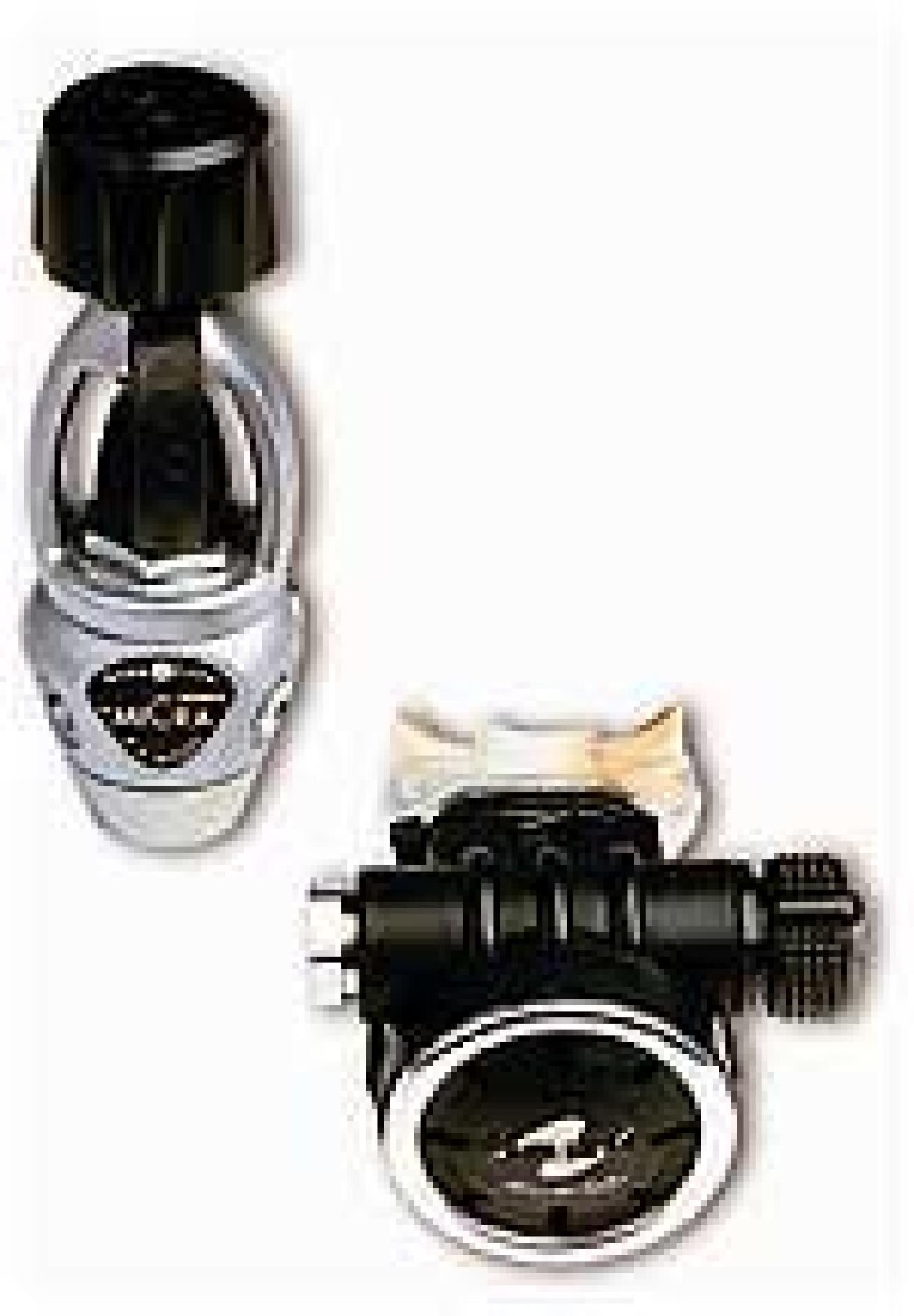
| | Aqua Lung Titan Micra ADJ|
First-stage type: Balanced diaphragm.
Low-pressure ports: 4.
High-pressure ports: 1.
First-stage swivel? No.
Second-stage adjustments: Switch.
THUMBS UP:
Excellent simulator performance.
Ease of breathing.
Ease of clearing.
Suitable for cold-water use.
Aqua Lung Titan Micra Adj ($399)
First-stage type: Balanced diaphragm.
Low-pressure ports: 4.
High-pressure ports: 1.
First-stage swivel? No.
Second-stage adjustments: Switch and dial.
THUMBS UP:
Extremely small second stage
Adjustments provide control over breathing
THUMBS DOWN:
Bubble interference
The Glacia is designed especially for use in cold water. Yet it is still competitively priced and performs well within this group of budget regulators, also earning a Testers' Choice designation. In the past, many cold-water regulators have offered significantly lower performance, but not so with the Glacia. It actually delivered air within Navy specs on most simulator test runs.
The Titan Glacia's cold-water modifications include: A first-stage dry chamber, second-stage heat exchangers, special surface treatment of second-stage metal parts, a displaced lever and thermal barrier in the second stage. The Glacia also has a lip protector that takes a little getting used to, but it quickly becomes easy to use and it does keep the lips warmer.
There have been several versions of the Micra over the years; in this case, the Micra Adjustable is combined with the smaller Titan first stage. The Micra second stage is exquisitely small, but the tradeoff is somewhat more bubble interference.
Both of these regs use a small min/max type switch to prevent free flows. Actually, this switch is a dive/pre-dive switch, and should be used only on the surface.
Both of these Aqua Lung regulators come with Comfo-Bite mouthpieces, which reduce the need to clamp down with the jaw muscles and lessen fatigue. Many divers love this feature, while others can't deal with it. It's easy to change mouthpieces if you don't care for it.
Genesis Scuba Atlas & Scuba Yukon
|| |---|
|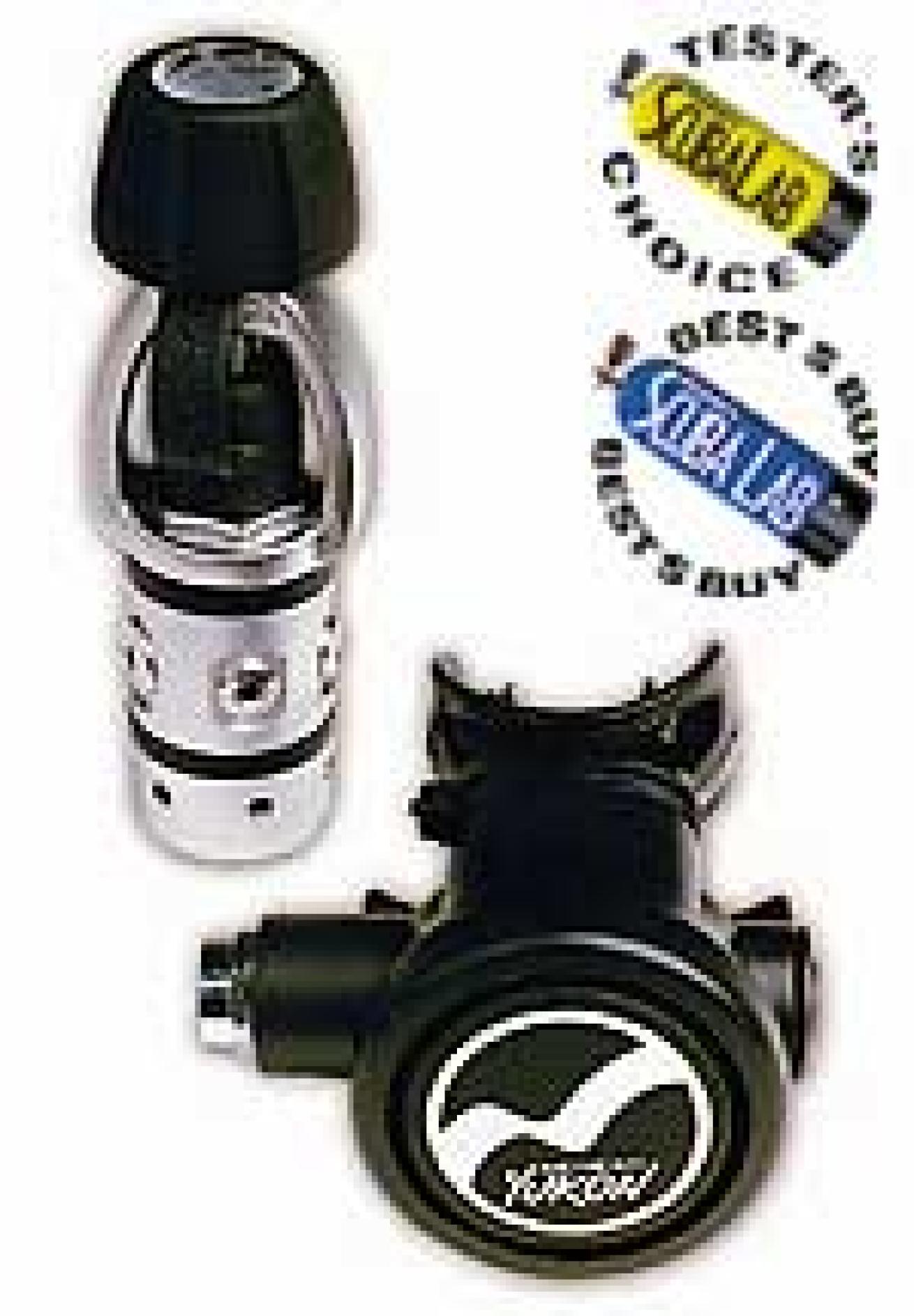
| | Genesis Scuba Yukon|
First-stage type: Piston.
Low-pressure ports: 4.
High-pressure ports: 2.
First-stage swivel? No.
Second-stage adjustments: Switch.
THUMBS UP:
Ease of clearing.
Ease of breathing.
THUMBS DOWN:
Significant variation in simulator tests at great depth.
Genesis Scuba Yukon ($260)
First-stage type: Piston.
Low-pressure ports: 4.
High-pressure ports: 1.
First-stage swivel? No.
Second-stage adjustments: None.
THUMBS UP:
Outstanding performance on simulator.
Ease of clearing.
Between these two Genesis Scuba regulators, the less expensive non-adjustable Yukon provided the more stable and repeatable performance, particularly at great depth. This earned the Yukon both Testers' Choice and Best Buy designations.
The Atlas has a small dive/pre-dive switch that can be used to prevent free flows on the surface. The switch is relatively easy to use, although it is quite small and is not clearly labeled. The ergonomics of the Atlas are somewhat better than those of the Yukon, as would be expected, so they are both excellent in-water performers, but the Yukon shines in price and stability.
Genesis Scuba provides well done owner's manuals with their regulators.
IDI Seaira Spirit Dia, Seaira Spirit Flowby & Seaira Tri-Metal
|| |---|
|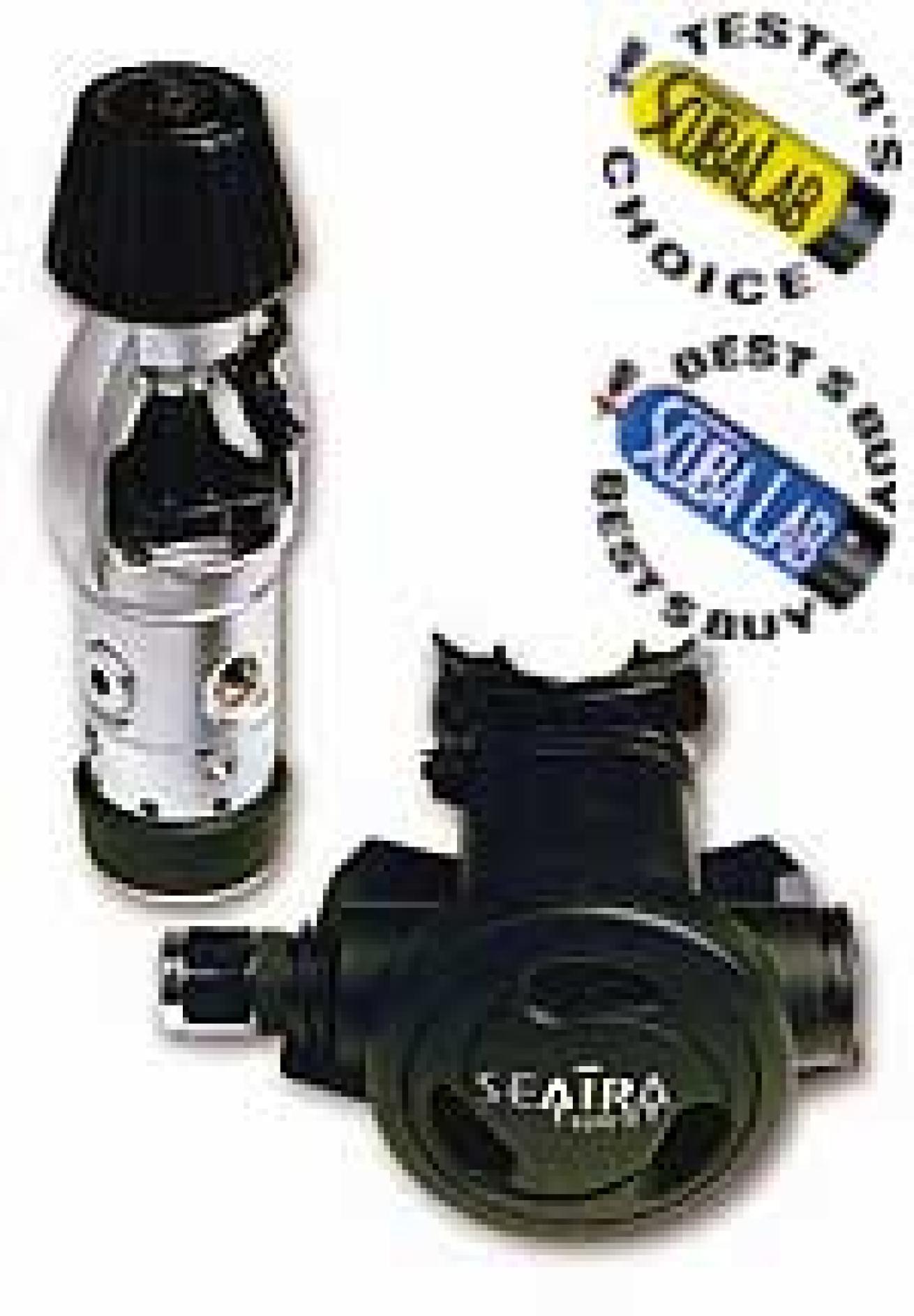
| | IDI Seaira Spirit Flowby|
First-stage type: Diaphragm.
Low-pressure ports: 4.
High-pressure ports: 2.
First-stage swivel? No.
Second-stage adjustments: None.
THUMBS UP:
Outstanding performance on simulator.
THUMBS DOWN:
Bubble interference.
Chatter on exhale.
IDI Seaira Spirit Flowby ($225)
First-stage type: Piston.
Low-pressure ports: 3.
High-pressure ports: 1.
First-stage swivel? No.
Second-stage adjustments: None.
THUMBS UP:
Outstanding performance on simulator.
Ease of breathing.
THUMBS DOWN:
Chatter on exhale.
IDI Seaira Tri-Metal ($400)
First-stage type: Balanced piston.
Low-pressure ports: 4.
High-pressure ports: 2.
First-stage swivel? Yes.
Second-stage adjustments: Dial.
THUMBS UP:
Outstanding performance on simulator.
Ease of clearing.
Ease of breathing.
THUMBS DOWN:
Chatter on exhale.
Adjustment is sticky.
IDI is a small manufacturer that has recently built an excellent reputation for high-performance regulators. Until now, IDI had no budget regulators of merit. No longer. All three of these models earned both Testers' Choice and Best Buy designations.
Each of these IDI regs has a different first stage and a different hose layout, but all three exhibited the same high level of performance on the breathing simulator. The two versions of the Spirit have solid ergonomic performance, while the Tri-Metal received the best in-water scores of any regulator tested here. The Tri-Metal's dial adjustment is sticky, as are the adjustments on the more expensive versions of this regulator that we have tested in the past.
All three of the regulators tend to chatter on exhale when the diver is looking downward. The owner's manuals for these regs are minimal, but do cover the essentials.
IST R600 Saturn & R700 Imperial
|| |---|
|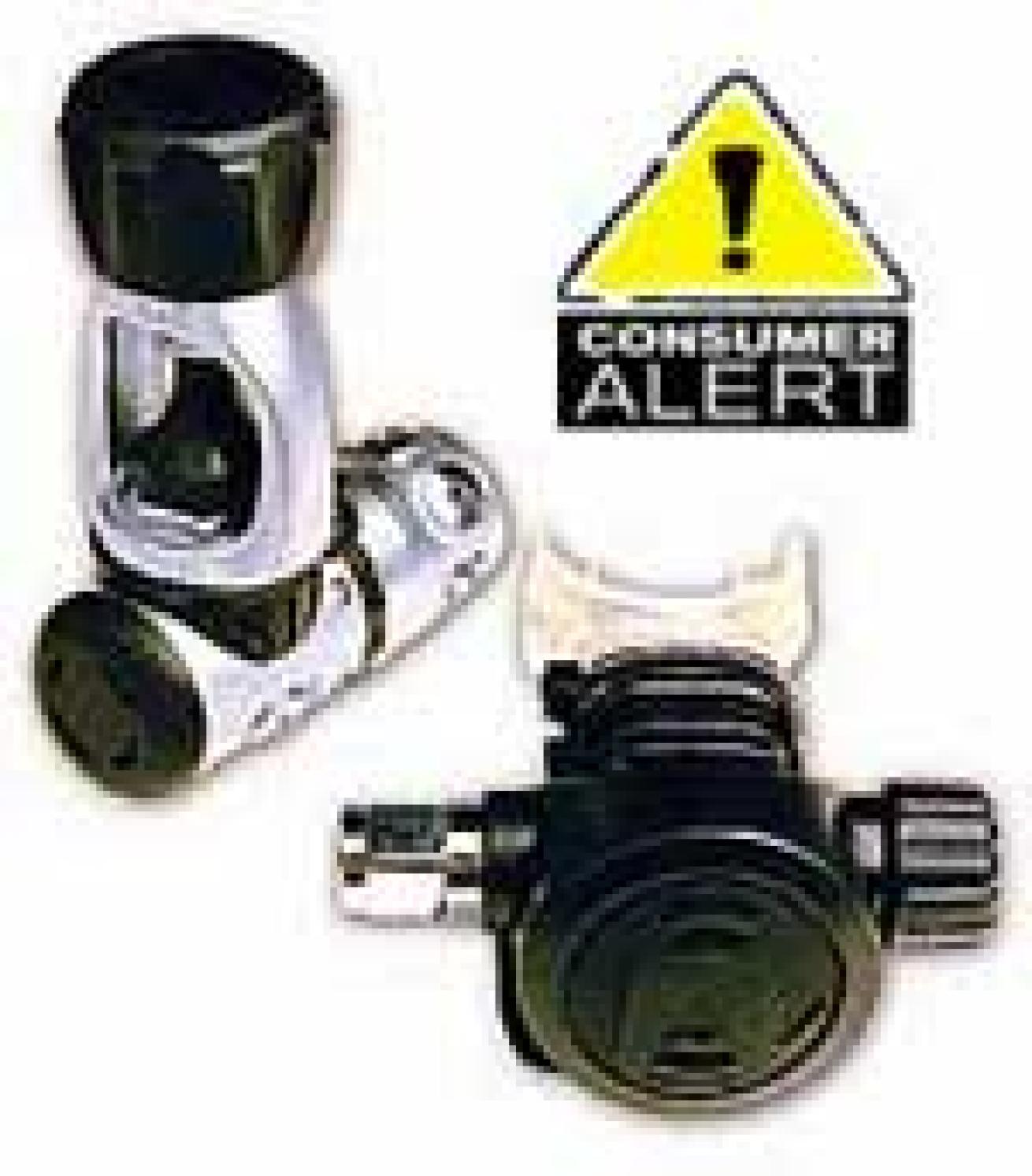
| | IST R600 Saturn |
First-stage type: Balanced piston.
Low-pressure ports: 4.
High-pressure ports: 2.
First-stage swivel? Yes.
Second-stage adjustments: Dial.
THUMBS DOWN:
Failed all breathing simulator tests.
Poor wet breathing.
Significant changes in breathing and wetness in differing positions.
IST R700 Imperial ($250)
First-stage type: Balanced piston.
Low-pressure ports: 4.
High-pressure ports: 2.
First-stage swivel? Yes.
Second-stage adjustments: None.
THUMBS DOWN:
Failed all breathing simulator tests.
Poor breathing, regardless of position.
Bubble interference.
Consumer Alert
These two IST regulators should not be used for scuba diving. Not only did they both fail every breathing simulator test, neither of them even made it to 66 feet on the objective machine tests. They performed worse than the private-label mail-order regulators we evaluated several years ago.
During the ocean ergonomic tests, the less expensive R700 did better than the adjustable R600. No owner's manuals are provided by IST. The poorly translated IST catalog tells us "Balance piston ... adjustable second stage will provide smooth effortless breathing." "Made with superb precision engineering ... designed to breathe effortlessly ... extremely safe ..."
These two regulators not only failed to meet U.S. Navy and European CE criteria, they could not function at 66 feet and were overbreathed by test divers in 30 to 40 feet of water.
Mares MR 12 Axis, MR 12 Epos & R2 Axis
|| |---|
|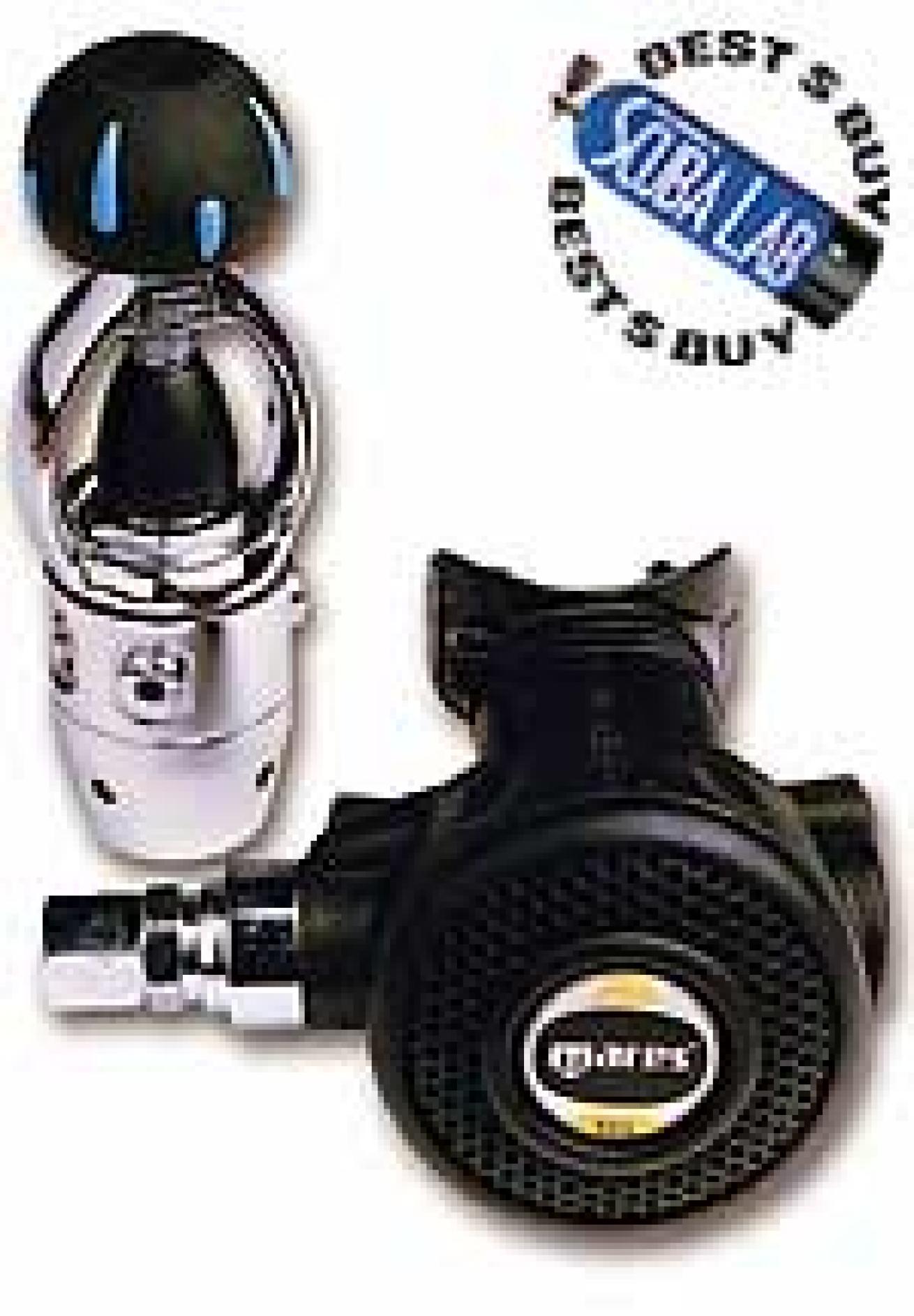
| | Mares R2 Axis |
First-stage type: Balanced diaphragm.
Low-pressure ports: 5.
High-pressure ports: 1.
First-stage swivel? No.
Second-stage adjustments: None.
THUMBS UP:
Excellent simulator performance.
Ease of breathing.
Ease of clearing.
Mares MR 12 Epos ($379)
First-stage type: Balanced diaphragm.
Low-pressure ports: 5.
High-pressure ports: 1.
First-stage swivel? No.
Second-stage adjustments: None.
THUMBS UP:
Excellent simulator performance.
Ease of breathing.
Ease of clearing.
Mares R2 Axis ($229)
First-stage type: Piston.
Low-pressure ports: 4.
High-pressure ports: 1.
First-stage swivel? No.
Second-stage adjustments: None.
THUMBS UP:
Excellent simulator performance.
Ease of breathing.
Ease of clearing.
Mares is well known for high-quality regulators, and these three all-new regs prove that:
The MR 12 Axis is a Testers' Choice and Best Buy.
The MR 12 Epos is a Testers' Choice.
The R2 Axis is a Best Buy.
Mares has been a leader in non-adjustable balanced diaphragm regulators that incorporate several successful patented designs into its regulators, including:
DFC"Dynamic Flow Control" minimizes the intermediate pressure drop from the first to the second stage. It works as claimed, but is available on only one of the low-pressure ports, therefore limiting the placement of the primary second stage hose.
VAD"Vortex Assisted Design" is a second-stage bypass that improves flow without excessive positive pressure breathing or the need for user adjustments. It also keeps the regulator stable without leaks or free flows.
Mesh gridThis second-stage cover design disperses water flow around the second stage diaphragm and thereby reduces the likelihood of free flows.
Pivoting deflectorAn innovation that helps to aim the flow of air in the second stage. On inhale, it aims the venturi at the mouth opening and moves out of the way on exhale. Of these regs, it is only on the Epos.
Mares does an outstanding job of quality control and of accurately and fairly representing the performance of its regulators. By comparing our test results with Mares' results, as supplied in its catalog, there is only a 0.1 plus or minus variation, about the same variation you would expect testing the same regulator on the same simulator on different days.
Mares uses a stiffer heavy-duty large diameter hose that makes the second stage less comfortable. The negative buoyancy of many of its second stages also reduces comfort. Mares' regulator instruction manuals are thorough and detailed.
Oceanic Explorers
|| |---|
|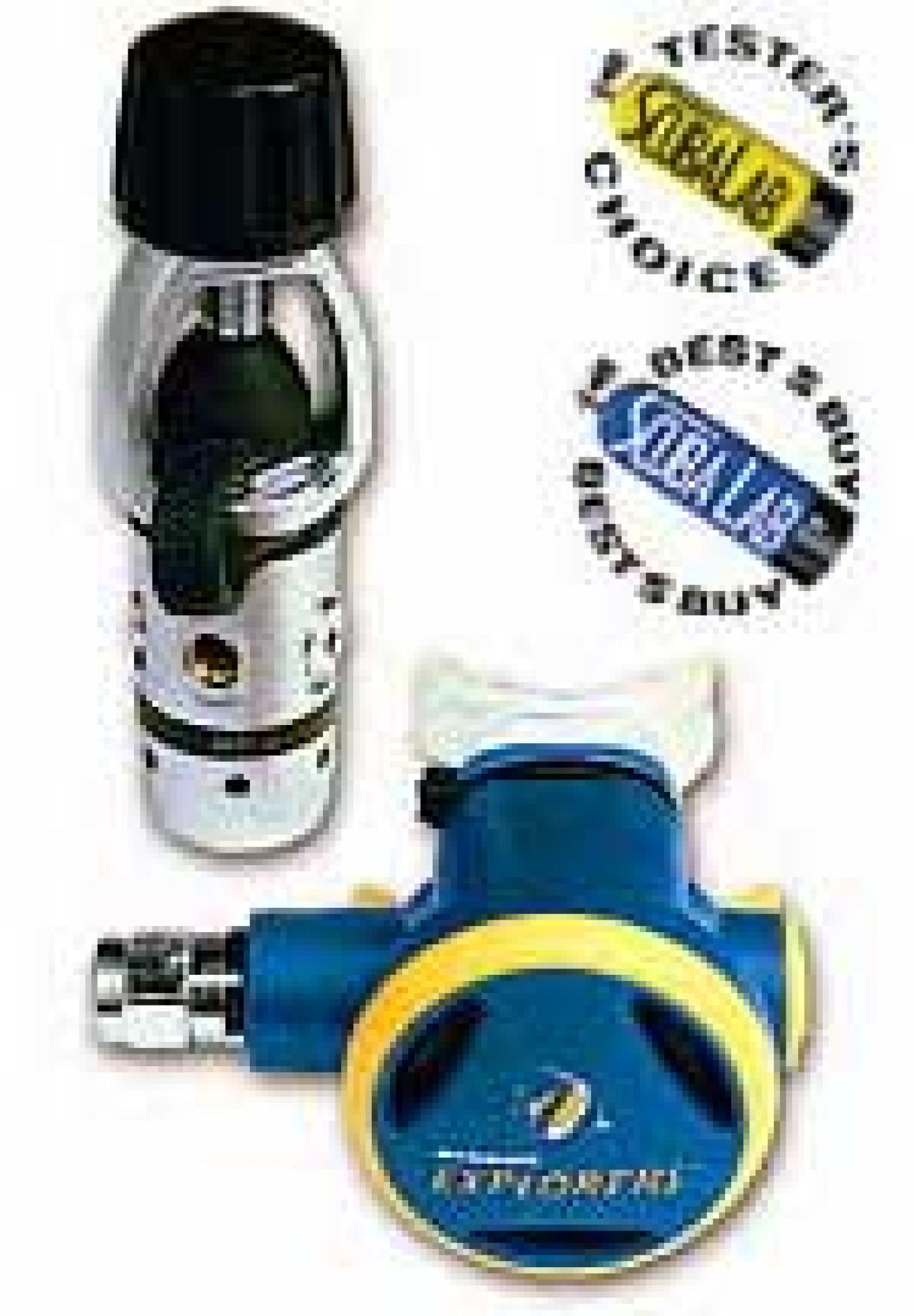
| | Oceanic Explorers |
First-stage type: Piston.
Low-pressure ports: 4.
High-pressure ports: 1.
First-stage swivel? No.
Second-stage adjustments: None.
THUMBS UP:
Excellent simulator performance.
Ease of breathing.
Ease of clearing.
In a way, the Oceanic Explorers regulator is both unique and new, yet at the time it is also a well-founded, excellent performing regulator. Explorers is the name of Oceanic's new children's line of dive equipment, introduced last year with BCs. Regulators have been added to the line, and it is planned eventually to include a full range of dive gear.
The Explorers regulator is a colorful version of Oceanic's simple budget regulators, which also have excellent breathing simulator performance as well as excellent in-water subjective test scores. The regulator's primary hose is shorter than most, at 24 inches versus a more typical length of 28 inches.
The Explorers comes very close to meeting the U.S. Navy criteria at 198 feet, a very respectable performance for a kid's regulator. Oceanic's owner's guide is among the best in the industry.
Ocean Reef 6600 Dynamic, Enterprise 6010 & Enterprise TR94 Polar
|| |---|
|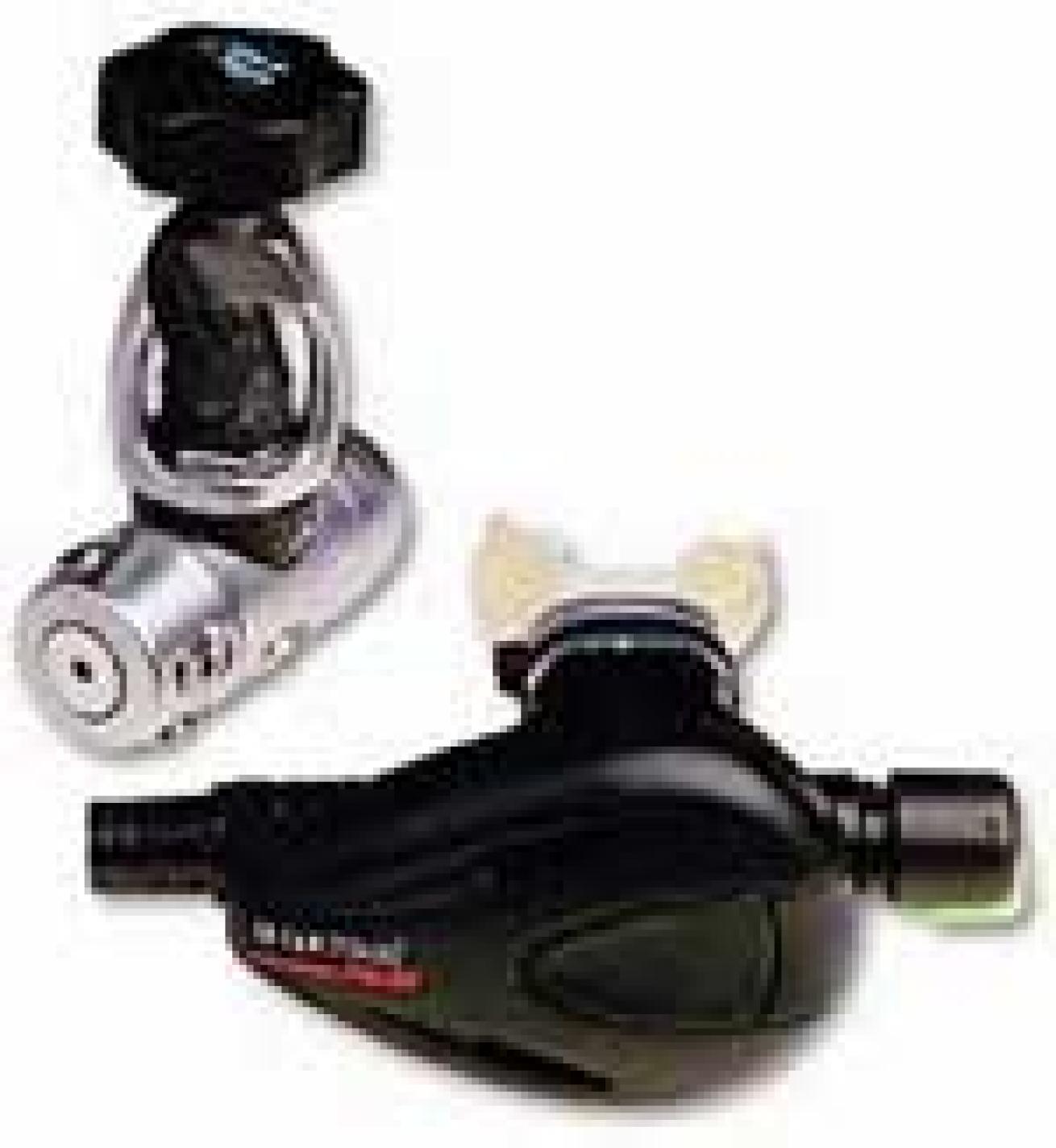
| | Ocean Reef Enterprise TR94 Polar |
First-stage type: Balanced piston.
Low-pressure ports: 4.
High-pressure ports: 2.
First-stage swivel? Yes.
Second-stage adjustments: Switch and dial.
THUMBS DOWN:
Poor simulator performance.
Adjustments difficult to use.
Ocean Reef Enterprise 6010 ($200)
First-stage type: Balanced piston.
Low-pressure ports: 3.
High-pressure ports: 1.
First-stage swivel? No.
Second-stage adjustments: None.
THUMBS UP:
Ease of clearing.
Ease of breathing.
THUMBS DOWN:
Poor simulator performance.
Bubble interference.
Breathes wet.
Ocean Reef Enterprise TR94 Polar ($332)
First-stage type: Balanced diaphragm.
Low-pressure ports: 4.
High-pressure ports: 2.
First-stage swivel? Yes.
Second-stage adjustments: Dial.
THUMBS DOWN:
Poor simulator performance.
Poor performance in odd position, particulary wet.
Bubble interference.
Ocean Reef (which also sometimes uses the older name "Ocean Edge") submitted these three regulators as new or redesigned regs. The least expensive 6010 outperformed both of its more expensive brethren.
The 6600 has two adjustments, neither of which is effective. In the poorly done owner's manual, the user is advised "For the Ocean Reef 6600, before a dive, make sure the dive/predive lever of the second stage is in the 'Dive' position." This advice is given with no illustration or description of the switch, which is not labeled on the regulator.
None of these three regulators passed U.S. Navy criteria at 99 feet, let alone 198 feet, where the test is actually conducted.
We have tested an earlier version of the Enterprise TR94 Polar with the same poor results. Ocean Reef's catalog contains a breathing simulator printout that shows the TR94's work of breathing to be 0.08 joules at the surface, a meaningless number. Regulators are not tested at the surface because there is no significant performance difference among regulators on the surface. Although regulators can be used on the surface, that is not their primary intended use. Furthermore, even the highest performing regulators would have a work of breathing of nearly 1 joule per liter at the surface.
The Ocean Reef catalog goes on to say that "The Enterprise TR94 is classified among the best regulators produced in Europe ... It obtained the best valuations from independent magazines in Great Britain, Germany and Italy." We would sure like to see those "valuations." At Scuba Lab, we have conducted many comprehensive tests, including two on the TR94. It has done so poorly, both times, that the work of breathing was twice the U.S. Navy limit and on some test runs it did not even make it to the Navy test depth. The TR94 owner's manual provides the following insight into its performance. "The balanced membrane system keeps its supply capacity unaltered irrespective of diving depth or the cylinder's pressure level." This about a regulator that shows a 26 to 46 percent increase in work of breathing from 99 to 198 feet, while its performance was already unacceptable at 99 feet.
Finally, included in the instructions is a warranty card that is to be mailed to Genoa, Italy. It is not clear how warranty problems in the U.S. would be handled.
Best of the Past
The excellent budget regulators presented here join nine other budget regs that have earned Testers' Choice or Best Buy designations in the past and are still in distribution. These are:
Aqua Lung Calypso ($215)
Beuchat USA VXTB Evolution ($369)
Oceanic Alpha 7 CDX ($299.95)
Oceanic Alpha 7 SP4 ($269.95)
Oceanic Gamma DX4 ($369.95)
Oceanic Gamma PX2 ($369.95)
ScubaPro MK2 Plus R190 ($256)
Sporasub Alto Plus ($273)
Sporasub Mini Compact ($220.50)

